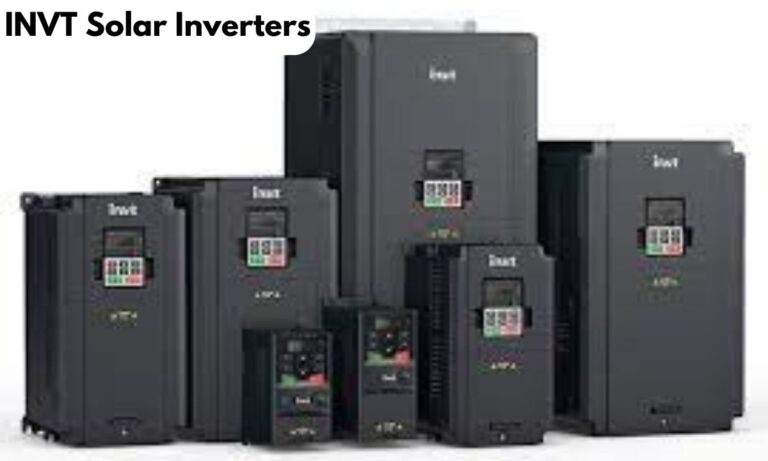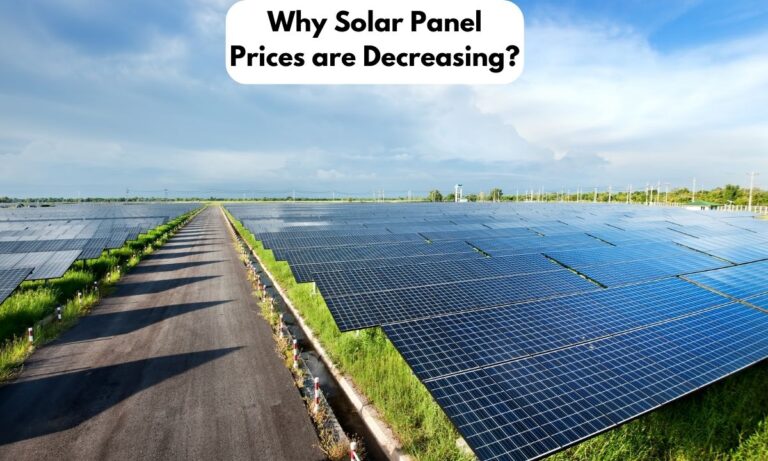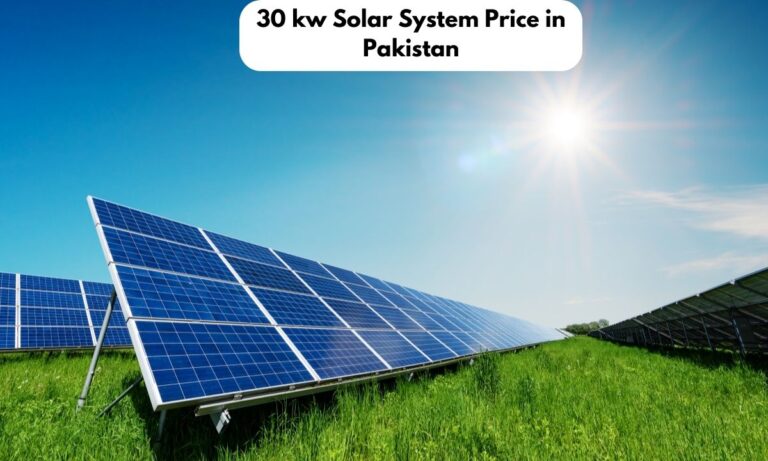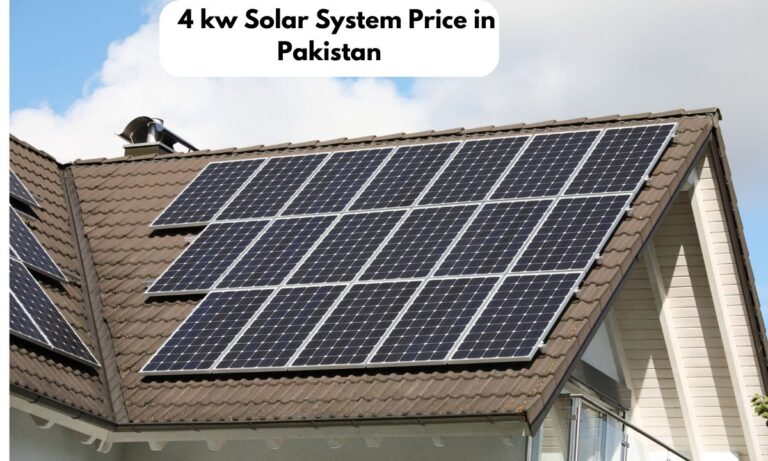8kw Solar System Price in Pakistan (Latest Guide)
Pakistan, the fifth largest country by population, is undergoing a big change in how it gets its energy. The solar energy market is expected to grow to 9.77 gigawatts in the next five years, increasing at a rate of about 49.68%.
This growth is happening because Pakistan gets a lot of sunlight, giving us a great chance to use solar energy almost all year round. If you’re thinking about installing an 8kw solar system in Pakistan, it can cost around Rs. 1,450,000 PKR, but it’s a smart way to lower your monthly electricity bills.
The cost of solar panels is going down, and there are more projects, especially in the utility sector, which are helping bring down the prices. The government is also supporting this by introducing policies like the new 25-year energy policy and the Net Metering Policy, making solar energy more accessible and affordable.
With the world focusing on sustainable solutions, the decreasing prices of solar panels in Pakistan are a positive sign, making solar energy a practical and affordable choice for our energy needs.

Different Brands of 8kw Solar Systems in Pakistan
| Brand | Model | Price |
| Zwienic | Inverter 8.5 (KW) 5G PV10000 | Rs. 310,000.00 |
| Zwienic | Inverter 8.5 (KW) Z6 6G PV10000 | Rs. 372,000.00 |
| Tesla | HLE 8kw | Rs. 460,000.00 |
| Inverex | Nitrox 8kw | Rs. 510,000.00 |
| Average cost | 8 kW solar system | between Rs. 1,217,000 to Rs. 1,682,000 |
| High Output Efficiency | 8KVA Solar Panel System 8KW On Grid Solar System | $5,689.00 – $5,799.00 |
Factors Influencing the Price of 8kw Solar Systems in Pakistan
The cost of 8kw solar systems in Pakistan is influenced by different things, like what’s happening globally, new technologies, and rules set by our local government. Let’s break down the main factors:
1. China’s Big Role: China has put a lot of money, more than $130 billion in 2023, into making solar stuff. Because of this, they now make more than 80% of the world’s solar parts. With so much being made, there’s extra supply, and that’s making solar panel prices go down worldwide, affecting prices here in Pakistan too.
2. Less Solar Stuff from Europe: Europe gets a lot of its solar stuff from China, and that’s been a bit risky for them. They haven’t built up their own solar-making system, so they depend a lot on imports. Because of this, solar panels from places like China are more available, helping bring down prices in Pakistan.
3. Better Technology: Solar panels are getting better thanks to new ideas and materials. High-efficiency panels and cool things like perovskites and organic semiconductors are making solar panels cheaper and more effective. This progress is part of why prices are going down.
4. Help from the Government: Our government is pushing for more solar energy. They’ve put in rules like the 25-year energy policy and the Net Metering Policy. Plus, they’re giving out perks like tax breaks, grants, and subsidies to support solar energy. These moves are creating more interest and investment in solar, which helps cut down on solar panel costs.
So, it’s not just one thing affecting solar prices in Pakistan; it’s a mix of what’s happening globally, the cool tech improvements, and the support from our own government.
Impact of Government Policies on Solar Panel Prices
Government policies play a vital role in shaping the solar panel market, affecting prices, and encouraging people to use solar energy. In Pakistan, some key policies have been crucial in boosting the growth of the solar industry and making solar power more reasonable. These include the new 25-year energy policy, the Net Metering Policy, and various financial perks like tax cuts, subsidies, and funding plans.
The New 25-Year Energy Policy: Our government is actively working on a fresh 25-year energy policy with big plans for renewable energy. They want 20-30% of all energy to come from renewable sources by 2030. This isn’t just about reducing our reliance on imported fuels but also increasing our use of homegrown, renewable resources. This long-term plan is expected to create a stable environment for investing in solar energy, leading to bigger projects and ultimately lower prices for solar panels.
Introduction of the Net Metering Policy: The Net Metering Policy is another smart move by the government to get more people to use solar energy. With this policy, if you generate extra electricity from your solar setup, you can send it back to the national grid and get credit for it. This makes solar setups more financially attractive for everyone – individuals and businesses alike. They can cut down on their electricity bills and even earn some extra money. This policy is a big reason why more people are getting into solar, creating more demand and pushing prices down.
Tax Cuts, Subsidies, and Funding Plans: To keep the solar panel market growing, the government is thinking about giving financial perks, like cutting taxes and offering subsidies on solar equipment. There’s even talk about not taxing solar equipment at all, making it cheaper for people to set up solar systems. Also, there are plans for financing schemes, so if you want to go for a solar project, it’s easier to get the money you need. These financial perks lower the initial costs of setting up solar power, making it a practical choice for more people and businesses.
In a nutshell, these government policies in Pakistan are making it easier and more attractive for everyone to tap into solar energy, from individual households to big businesses.
Market Trends and Future Outlook
The solar energy scene in Pakistan is gearing up for some serious growth, with estimates pointing to a jump from 1.30 gigawatts to an impressive 9.77 gigawatts in the next five years. That’s like a supercharged growth rate of over 49.68% every year. What’s powering this surge? Well, our country gets a ton of sunlight, making it a hot spot (literally) for solar power year-round. And it’s not just local efforts – foreign investments and smart solutions for off-grid power in rural areas are adding fuel to the fire.
Taking Over the Utility Sector: In this solar revolution, the utility sector is set to be the big player. Why? Because the cost of solar stuff is dropping, and there’s a bunch of new projects on the horizon. Massive solar power plants, medium-sized projects, and even solar panels on big government buildings are all part of a grand 9 GW solar plan. The goal? To push out the pricier and more polluting ways we currently make electricity.
Government Got Our Back: Our government is playing a superhero role here. They’ve set ambitious goals, like getting 30% of our power from renewable sources by 2030. They’ve got some cool plans, too, like letting us sell extra electricity back to the grid (net metering) and throwing in financial perks like tax breaks, subsidies, and easy financing for solar setups. These moves not only boost the solar market but also make solar energy a wallet-friendly choice for regular folks and businesses.
Bumps in the Road and Bright Spots: Now, it’s not all sunshine and rainbows. One big hurdle is that we mostly rely on imported solar panels, which can be pricey and cause headaches in the supply chain. The solution? Set up local factories, which could make things cheaper, more available, and create jobs. But, of course, this needs serious cash and tech skills.
Tech is our buddy here, too. Fancy improvements in solar tech, like perovskite solar cells, could make panels work better and cost less. Innovations in making panels and the materials involved could also chip in for cheaper solar power.
But hold on, there’s more work to do. Many folks in Pakistan aren’t fully clued in on the perks of solar power or the sweet deals the government is offering. So, spreading the word through education campaigns and giving clear info on why solar is awesome and how it saves money can boost demand and, you guessed it, bring those prices down.
So, while we’re basking in the sun’s glory, a lot is happening behind the scenes to make solar power a real game-changer in Pakistan.
Conclusion
The solar energy scene in Pakistan is changing a lot, thanks to a mix of global trends, cool tech upgrades, and helpful government rules. China is making a ton of solar panels, making them more available and pushing prices down. Better technology means we have super-efficient solar panels that don’t break the bank. Plus, our government is backing solar power with plans like the new 25-year energy policy, the Net Metering Policy, and some financial perks.
Looking forward, the future of solar power in Pakistan looks bright. With the solar market growing and the utility sector taking charge, along with ongoing government support, solar energy is becoming a real option for our energy needs.
This isn’t just good for making sure we have enough power but also for the environment since solar energy is clean and keeps coming back. But, there are some hurdles, like needing to make our own solar panels, tech improvements making things even cheaper, and making sure people know about the benefits of solar energy. Fixing these challenges will help us make the most of solar power in Pakistan.






